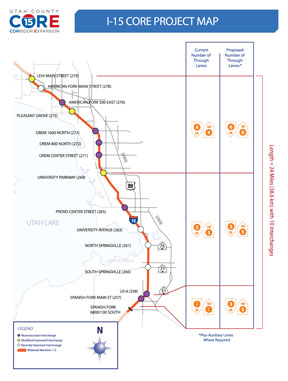by Tiffany DeMasters
Updated at 08:22am, October 8, 2016
BRIGHAM CITY, Utah — A construction worker is in critical condition after an industrial accident involving a concrete laying machine (a Gomaco slipform paver) on northbound Interstate 15 Friday afternoon.
Authorities received a call about the accident at about 2:36 p.m., which occurred in the construction zone just south of exit 362. The worker, a 39-year-old man from Layton, was working with the machine and was on the east side working under the machine on an area called Dow Bar Inserter, according to Utah Highway Patrol.
The worker’s job was to make sure the dow rods were properly inserted into the cement as it was laid.
Somehow the Layton man got pinned between the ground and the paver machine, which crushed against him, according to UHP.
The worker was flown to McKay Dee Hospital in critical condition.
===
THIS is a Paving Project– The I-15 CORE - Page 1
 Provo, Utah – The scope of the I-15 Corridor Expansion Project (I-15 CORE) in the state of Utah is nearly unprecedented because of the size of the project and the short completion deadline. Twenty-four miles (38.6 km) of removal and replacement of Interstate 15 between Lehi and Spanish Fork, widening the number of traveling lanes by two, for up to six lanes in each direction in 35 months. The new 364 lane miles (586 km) of concrete roadway will be slipformed 12 or 12.5 inches (305 or 318 mm) thick for a total of 2.67 million square yards (2,232,460 m2) of Portland Cement Concrete Pavement (PCCP). All of it slipformed with GOMACO pavers.
Provo, Utah – The scope of the I-15 Corridor Expansion Project (I-15 CORE) in the state of Utah is nearly unprecedented because of the size of the project and the short completion deadline. Twenty-four miles (38.6 km) of removal and replacement of Interstate 15 between Lehi and Spanish Fork, widening the number of traveling lanes by two, for up to six lanes in each direction in 35 months. The new 364 lane miles (586 km) of concrete roadway will be slipformed 12 or 12.5 inches (305 or 318 mm) thick for a total of 2.67 million square yards (2,232,460 m2) of Portland Cement Concrete Pavement (PCCP). All of it slipformed with GOMACO pavers.The I-15 CORE is the largest construction project the state of Utah has ever undertaken. The only project that can compare was also on the I-15, the I-15 Corridor Reconstruction, in Salt Lake City, which began in 1997. The Utah Department of Transportation (UDOT) project rebuilt 16 miles (25.7 km) of freeway using a design/build approach with a budget of over $1.3 billion and a four and one-half year completion schedule. The project was completed in the summer of 2001, well in advance of the 2002 Winter Olympics held in Salt Lake City and the surrounding area. The consortium in charge of the project used all GOMACO pavers to slipform that project.

Fixed-Price/Best-Design Format
Ten years ago, UDOT began the process to reconstruct more of the I-15. They wanted to rebuild an additional 43 miles (69.2 km), starting from where the I-15 Corridor Reconstruction project ended at 123rd South in Salt Lake City going south to the town of Payson. Funding was assigned to the project in 2007.
“Then, like most states, we went through some hard times and the funding for the project was cut from $3.25 billion all the way back to $1.725 billion,” Robert Stewart, Deputy Project Director for the CORE Project, explained. “We were forced into this decision point and had to ask the question, ‘What do we do?’
“We decided to put this project out in a fixed-price/best-design format. Essentially we said, ‘Contractors, here’s the contract amount. You propose to us what you can build for the contract amount of $1.2 billion.’”
It’s the first time UDOT has used the fixed-price/best-design format on one of their projects. They had carefully watched the success of the I-69 Interstate project through St. Louis, Missouri, and determined it would work on the I-15. UDOT created a specific list of “must have” requirements for their project, as well as an additional list of “wants” for the bidding consortiums.
“It’s the first time we’ve done this in Utah... the concept of just putting out a price and having proposers come back to us and tell us the scope,” Stewart said. “We asked for a project completion date for December 2014. And among other things, we specified a 30-year design, and we required the proposers to submit a life-cycle cost analysis. In our goals and values that we provided to the proposers, we emphasized that we preferred concrete. We didn’t require it, but we preferred it.”



